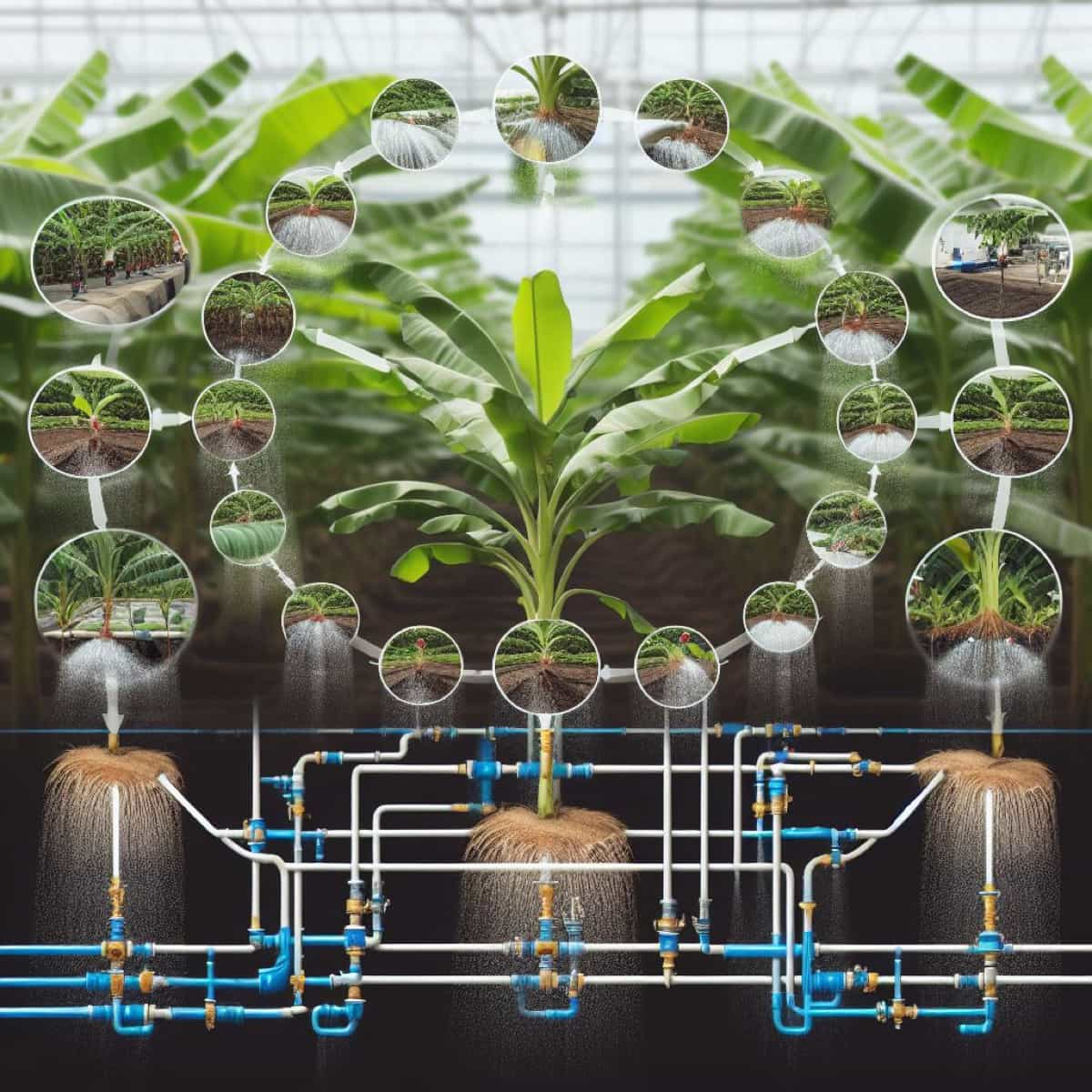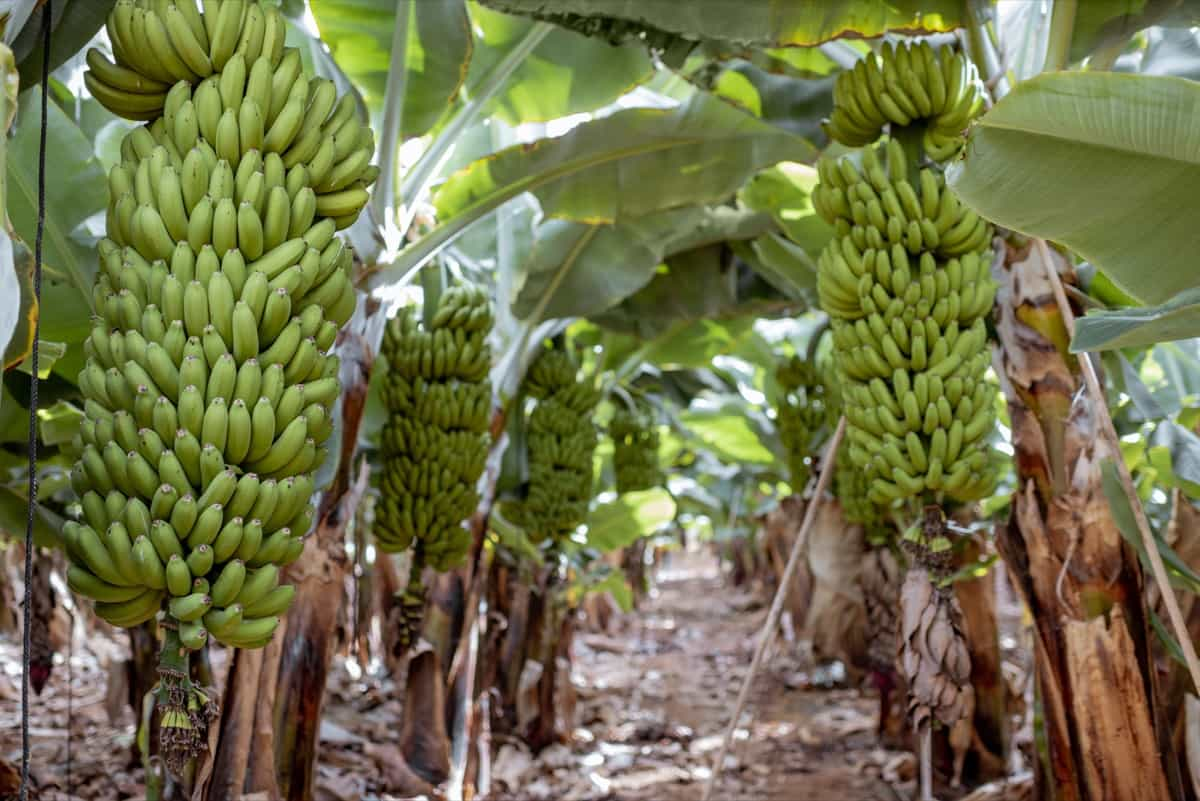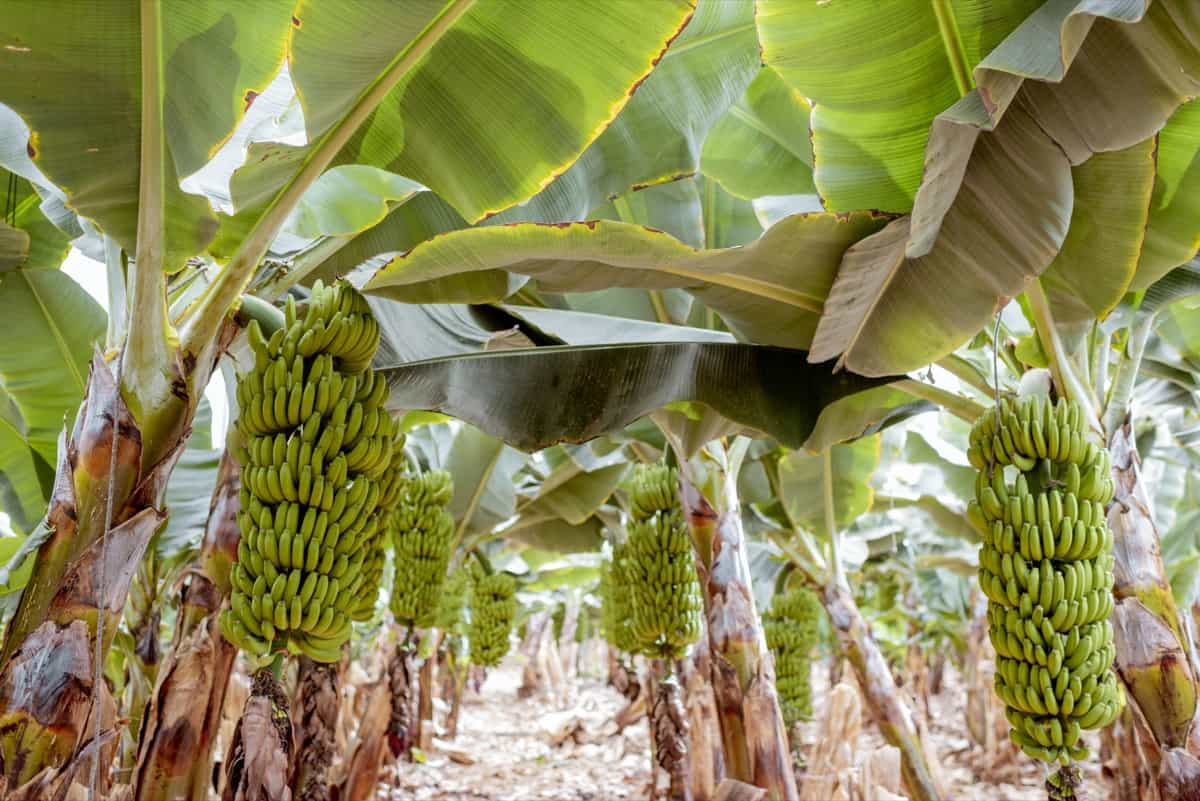Banana cultivation is a vital agricultural sector, providing nutritious fruits to millions worldwide. Innovative farming practices, such as drip irrigation, are crucial for the industry’s success. This article explores how drip irrigation can increase fruit size and yields in banana plantations while addressing challenges and benefits and highlighting the potential of this technique.

Drip Irrigation in Banana Plantations
The construction of a network of tubes and emitters that deliver water and nutrients gradually and directly to the root zone is required to implement drip irrigation in banana plantations. This technique differs from conventional overhead irrigation systems, which can cause unequal distribution and water waste. In banana farming, drip irrigation has become popular because it offers a regulated and effective means of supplying plants with the water and nutrients they need.
How Drip Irrigation in Banana Plantations Will Increase Fruit Size and Yields
- Optimal Moisture Supply: Drip irrigation ensures plants don’t face drought or waterlogging, promoting continuous growth and fruit development by providing a consistent moisture supply to the roots.
- Nutrient Delivery: Drip systems, when properly controlled, provide essential nutrients and water, promoting robust growth and larger, healthier fruit.
- Reduced Stress: Precise irrigation reduces stress on banana plants due to fluctuating soil moisture levels, resulting in more consistent growth and improved fruit production.
- Root Zone Health: Drip irrigation enhances the health of the root zone. Healthy root systems can more efficiently absorb water and nutrients, further supporting fruit size and yield.
Why Fruit Size and Yields Are Important in Banana Plantations
- Market Value: Larger bananas are often more visually appealing and can command higher prices in the market. Improved fruit size can significantly impact the economic returns for banana farmers.
- Consistent Supply: Enhanced yields ensure a consistent supply of bananas, meeting consumer demand and keeping the market well-supplied year-round.
- Profitability: Higher yields and larger fruit translate to increased profitability for banana farmers, helping them sustain and grow their operations.
- Economic Sustainability: A robust banana industry contributes to the economic sustainability of the regions where these plantations are located, providing employment and supporting local economies.
In case you missed it: How Mulching in Banana Farming Helps to Achieve High Yields with Less Water

Drip Irrigation Helps Save Water in Banana Plantations
- Environmental Responsibility: Drip irrigation is an environmentally responsible practice, reducing the environmental impact of water-intensive agriculture.
- Water Resource Management: Water scarcity is a growing concern in many regions. Drip irrigation allows farmers to make the most efficient use of available water resources.
- Reduced Costs: Water savings can lead to reduced water costs for banana farmers, enhancing the economic viability of their operations.
- Sustainable Farming: Water conservation practices are vital for the long-term sustainability of banana farming, ensuring that this industry can thrive in the face of changing environmental conditions.
We Can Improve Nutrient Absorption Using Drip Irrigation in Banana Plantations
Banana plants’ root zones can receive a balanced supply of vital nutrients using tailored drip irrigation systems. This targeted nutrient delivery enhances the plant’s ability to absorb these elements efficiently, contributing to robust growth and larger, healthier fruit.
- Nutrient Efficiency: Drip irrigation minimizes nutrient losses due to leaching or runoff, maximizing the utilization of applied nutrients by the plants.
- Reduced Environmental Impact: Nutrient runoff from conventional farming can lead to water pollution. Drip irrigation helps reduce this environmental impact by keeping nutrients where they are needed—within the root zone.
Drip Irrigation Helps Control Soil Moisture in Banana Plantations
- Preventing Drought Stress: By using drip irrigation, banana trees are protected from extended drought stress, which can have a detrimental effect on their development and fruit quality.
- Avoiding Waterlogging: The system prevents excess water accumulation in the root zone, reducing the risk of waterlogged soil, which can harm root health.
- Consistent Growth: Stable soil moisture levels promote consistent growth and development, resulting in larger and healthier bananas.
Drip Irrigation Reduces Weed Competition in Banana Plantations
Weed competition is a common challenge in banana plantations, as weeds compete with banana plants for nutrients and water. Drip irrigation can help mitigate this issue by reducing the moisture available to weeds. Drip irrigation improves nutrient availability for banana plants by reducing weed competition. This reduces labor costs and time spent on manual weeding. Additionally, it enhances plant health by allowing banana plants to focus on growth, leading to larger, more robust fruit.
In case you missed it: Organic Banana Farming: How to Grow Chemical-Free Bananas

Drip Irrigation Can Control Diseases and Pests in Banana Plantations
Drip irrigation can also aid in disease and pest management in banana plantations. By keeping the foliage dry, it reduces the risk of fungal diseases that thrive in humid conditions. Drip irrigation benefits fungal disease prevention, pest resistance, and reducing the need for chemical pesticides. It keeps plants dry, reducing the growth of fungal pathogens. Additionally, it boosts natural plant defenses, making them less susceptible to pest attacks. This promotes environmentally friendly farming practices.
Drip Irrigation Enhances Root Development and Growth in Banana Plantations
- Better Absorption of Water and Nutrients: Sturdy root systems have a greater capacity to absorb water and nutrients, giving plants the building blocks, they require to thrive.
- Stability and Support: Plants with robust root systems are more stable and less likely to topple over in unfavorable weather.
- Drought Resistance: Plants with deeper and denser roots are more resilient to drought stress, which enhances the general health and robustness of the plant.
Fertilizer Application is Optimized with Drip Irrigation in Banana Plantations
Drip irrigation systems allow for precise control over fertilizer application. Farmers can tailor the nutrient mix and timing to the specific needs of banana plants. This optimization contributes to the growth and development of healthier banana trees and, ultimately, larger and more abundant fruit.
Drip irrigation allows farmers to customize their banana plants’ nutrient supply, addressing deficiencies and imbalances. This reduces nutrient waste by minimizing leaching and reducing environmental impact. Efficient fertilizer also saves costs, as farmers can purchase and apply fewer nutrients while achieving better results.
Drip Irrigation Can Maximize Fruit Quality in Banana Plantations
Consistency in water and nutrient supply provided by drip irrigation results in high-quality fruit. Well-nourished bananas exhibit better taste, texture, and visual appeal, which can lead to higher market prices and consumer satisfaction. Nutrient-rich bananas offer enhanced taste and texture, boosting consumer satisfaction, and can increase market prices due to their larger, healthier size.
Proper Water Management Increases Fruit Size and Yields in Banana Plantations
The efficient use of water resources through drip irrigation is not only environmentally responsible but also a key factor in increasing fruit size and yields in banana plantations. Proper water management is a cornerstone of sustainable and profitable banana farming. Responsible water use in banana farming reduces environmental impact, enhancing long-term sustainability. Water savings lead to reduced operational costs, enhancing economic viability. Effective water management practices are crucial for sustainable agriculture, ensuring industry survival in changing environmental conditions.
Cost of Drip Irrigation in Banana Plantation on 1-Acre Basis
The cost of drip irrigation in a banana plantation can depend on factors such as the size of the plantation, local conditions, and the type of system chosen. On a 1-acre basis, costs typically include equipment, installation, and maintenance.
- The type of irrigation technology chosen will determine the cost.
- The cost per acre for inline planting might be as high as Rs. 50,000.
- An acre of drip tape with pre-punched holes measuring 250 microns would cost around Rs. 20,000. The drip tape would last for four years.
- Prepunched drip tape has the advantages of having very little upfront cost and unblockable drip holes.
In case you missed it: How to Manage Pests and Diseases in Banana Plantation: How to Control and Prevent with Different Practices

Frequently Asked Questions on Drip Irrigation in Banana Plantations
Can Drip Irrigation be Retrofitted into Existing Banana Plantations?
Yes, drip irrigation can often be retrofitted into existing plantations, though the process may require some adjustments to the layout.
Are There Any Government Incentives or Programs to Support the Adoption of Drip Irrigation in Agriculture?
Government incentives and programs in some regions may encourage water-saving and sustainable agricultural practices like drip irrigation, so farmers should consult local authorities for more information.
Conclusion
Drip irrigation in banana plantations offers benefits like increased fruit size, yields, water conservation, improved nutrient absorption, and disease control. It optimizes root development and fruit quality, making it a valuable asset for the industry. Despite initial costs, long-term environmental and profitability benefits make it a game-changer.
- Feed Your Flock for Less: Top 10 Tips to Save on Chicken Feed
- Ultimate Guide to Ossabaw Island Hog: Breeding, Raising, Diet, and Care
- Hatching Answers: The Top 10 Reasons Your Chickens Aren’t Laying Eggs
- Eggs and Economics: Breaking Down the Cost of Raising Backyard Chickens
- Defend Your Greens: Proven Methods to Keep Iguanas Out of Your Garden
- Ultimate Guide to Cinnamon Queen Chicken: A Comprehensive Guide for Beginners
- Ultimate Guide to California Tan Chicken: Breeding, Raising, Diet, Egg-Production and Care
- Ultimate Guide to Marsh Daisy Chicken: Breeding, Raising, Diet, and Care
- 10 Types of Chicken Farming Businesses You Can Start for Profits